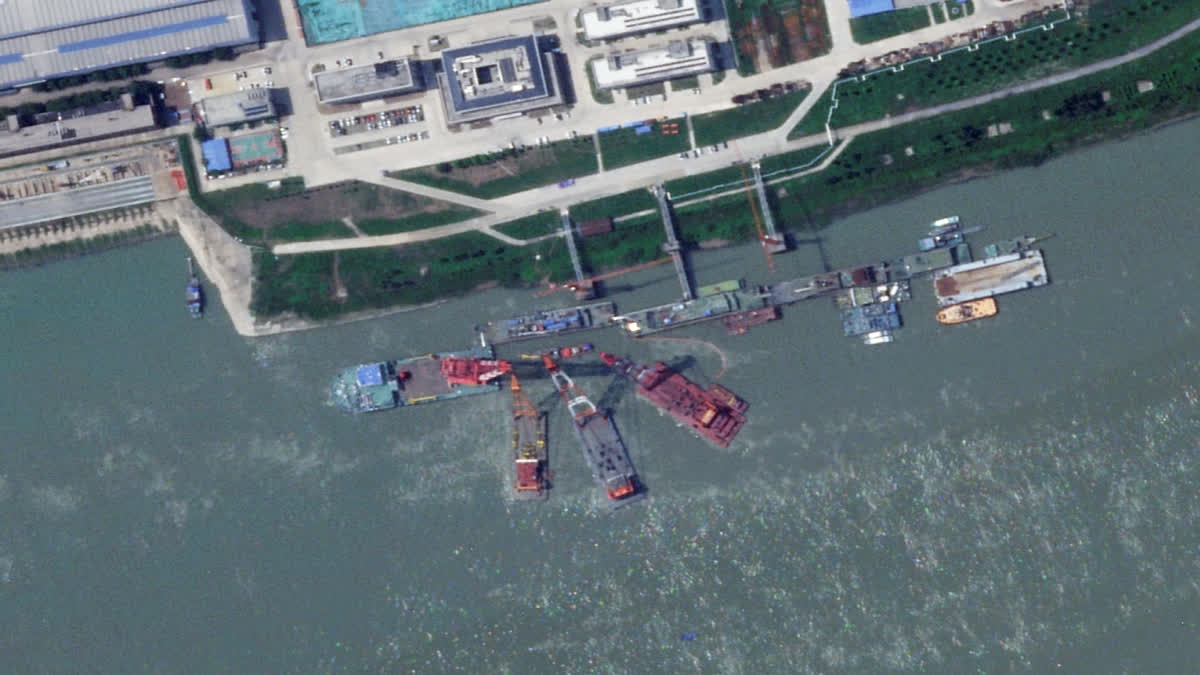Washington: Satellite imagery showed that China's newest nuclear-powered attack submarine sank alongside a pier while under construction, a senior U.S. defence official said Thursday. The sinking of China's first Zhou-class submarine represents a setback for Beijing as it continues to build out the world's largest navy. Beijing has become increasingly assertive in pursuing its claim to virtually the entire South China Sea, which is crucial to international trade.
Meanwhile, China faces longtime territorial disputes involving others in the region including Brunei, Malaysia, the Philippines, Taiwan and Vietnam. The United States has sought to strengthen ties to its allies in the region and regularly sails through those waters in operations it says maintains the freedom of navigation for vessels there, angering Beijing.
The submarine likely sank between May and June, when satellite images showed cranes that would be necessary to lift it off the bottom of the river, said the official, who spoke on condition of anonymity to provide details about the submarine loss. China has been building up its naval fleet at a breakneck pace, and the U.S. considers China’s rise one of its main future security concerns.
A Chinese Foreign Ministry spokesperson said Friday he was not familiar with the topic and did not provide any information when asked about it at a Beijing press conference. The U.S. official said it was “not surprising” that China's navy would conceal it. The submarine's current status is unknown.
The identification of the sunken nuclear submarine was first reported by The Wall Street Journal. Thomas Shugart, a former U.S. Navy submariner and an analyst at the Center for a New American Security, first noticed the incident involving the submarine in July, though it wasn't publicly known at the time that it involved the new Zhou-class vessel.
China as of last year operated six nuclear-powered ballistic missile submarines, six nuclear-powered attack submarines and 48 diesel-powered attack submarines, according to a U.S. military report. News of the submarine's sinking comes as China this week conducted a rare launch of an intercontinental ballistic missile into international waters in the Pacific Ocean. Experts say it marked the first time Beijing had conducted such a test since 1980.
Worst Submarine Disasters At A Glance
Following is a chronology of major accidents involving nuclear submarines since 1968
April 10, 1963: The USS Thresher, while conducting deep water test dives 200 miles east of Cape Cod, lost power and imploded in 8,400 feet of water. All 129 men aboard were killed instantly. The incident remains the worst submarine disaster in history.
May-June 1968: U.S. Navy submarine Scorpion sinks with 99 men aboard east of Norfolk, Virginia.
March 4, 1970: French submarine, the Eurydice, sinks with 57 crew off St. Tropez in the Mediterranean Sea.
April 12, 1970: A Soviet November class nuclear-powered attack submarine sinks with 88 crew members in the Atlantic Ocean off Spain.
Aug 10, 1985: An explosion on a Russian submarine at Chazma Bay, on the Pacific coast near Vladivostok, sends the lid of the reactor flying hundreds of metres with no trace of the 10 people working in the reactor.
April 7, 1989: A Soviet Mike class attack submarine sinks off northern Norway with the loss of 42 lives after a fire.
Aug 12, 2000: The Russian Oscar-II class submarine Kursk with 118 crew members sinks to the bottom of the Barents Sea after possibly a collision and two explosions on board.
February 9, 2001: The Greenville, a 360-foot U.S. Navy submarine based at Pearl Harbour, sinks a Japanese trawler after colliding with it, killing nine civilians aboard the fishing boat.
May 2003: In May 2003, China announced that the entire ship's crew of 70 people had been killed aboard the Ming-class submarine 361 due to a mechanical malfunction. The accident took place off the coast of Liaoning Province in northeast China.
Jan 2005: One crewman dies after the U.S. nuclear submarine San Francisco runs aground off Guam in the Pacific Ocean. Another 23 crewmen were injured.
September 6, 2006: Fire on board the Viktor-3 class Russian navy submarine St Daniel of Moscow, moored near the Finnish border, kills two crew members.
March 21, 2007: Two British soldiers were killed and another injured on the Tireless nuclear submarine during an exercise in the Arctic.
Nov 8, 2008: More than 20 people were killed and another 21 injured on a Russian nuclear submarine in the Pacific.
August 14, 2013: Russian-built submarine INS Sindhurakshak an Indian submarine sank after an explosion killing 18 sailors and two officers.
November 15, 2017: The Argentine submarine ARA San Juan holding a crew of 44 was reported missing off the coast of Argentina while on a training exercise. It was found in 2018 November after it vanished in the South Atlantic. All the crew were declared dead.
April 24, 2021: KRI Nanggala (402), a missing Indonesian Navy submarine, was found on the sea floor and all 53 crew and passengers aboard were confirmed dead. The submarine had failed to report for a post-manoeuvre brief following a torpedo live fire exercise in the Bali Sea, in an area where the water is 700 metres deep days earlier and was declared missing.
August 21, 2023: Chinese Nuclear attack Submarine accident: An undisclosed UK defence report hints at a devastating incident involving a Chinese submarine, the ‘093-417’, in the Yellow Sea. The report suggests that 55 Chinese sailors, including the captain and 21 officers, may have died due to a “catastrophic failure, in the vessel’ s oxygen systems, the Daily Mail reported. Dead include the captain Colonel Xue Yong-Peng.



